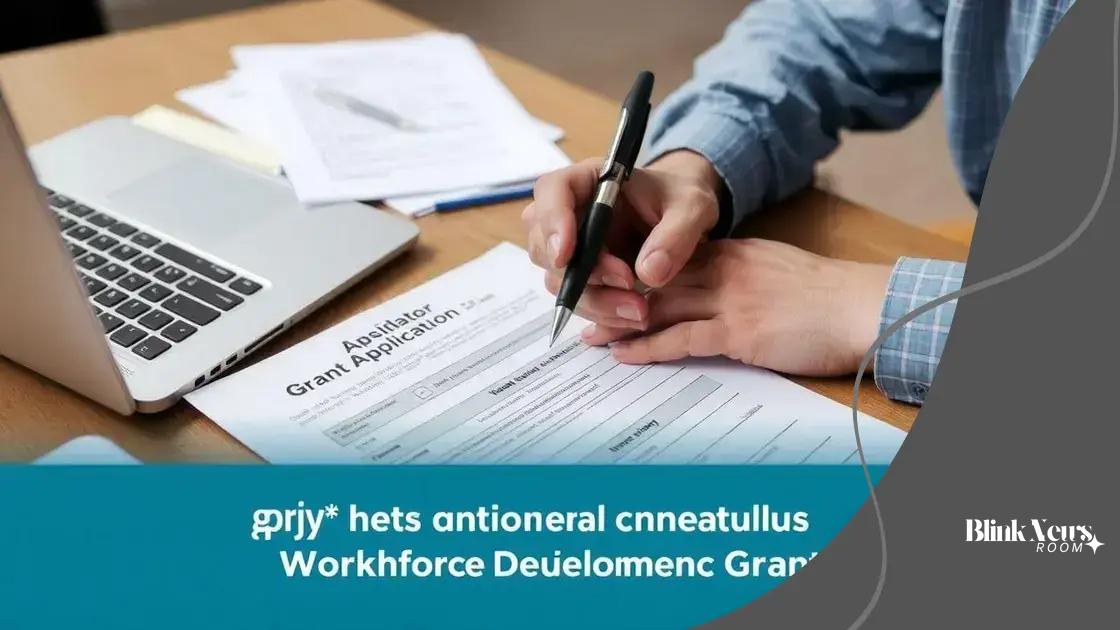Workforce development grants: Unlock new opportunities

Anúncios
Workforce development grants provide financial resources to organizations and individuals for training programs, focusing on enhancing job skills, addressing workforce needs, and promoting diversity and inclusion in the labor market.
Workforce development grants are essential for individuals and organizations looking to enhance skills and empower communities. You might wonder how these grants can specifically help you or your organization. Let’s dive into the world of funding opportunities available for workforce development.
Anúncios
Understanding workforce development grants
Understanding workforce development grants is essential for anyone looking to enhance skills and improve job opportunities. These grants provide financial support to individuals and organizations focused on training and workforce development.
What Are Workforce Development Grants?
Workforce development grants are funds awarded by government agencies, foundations, or organizations aimed at enhancing employment skills and job readiness. They can cover various expenses, including tuition, training materials, and even salaries for instructors.
Benefits of Workforce Development Grants
These grants have numerous benefits that help strengthen the workforce:
Anúncios
- Financial support: Alleviates the burden of training costs for individuals and organizations.
- Skill enhancement: Provides opportunities for acquiring new competencies and certifications.
- Community growth: Enhances the local economy by creating a more skilled labor force.
- Networking opportunities: Encourages collaboration between businesses and training providers.
Moreover, workforce development grants often prioritize specific populations, such as veterans, unemployed individuals, or those in underserved communities. This focus helps ensure that resources are directed to those who need them the most.
Many grants require applicants to demonstrate a clear plan and impact. This means presenting objectives, budgets, and outcomes that can be measured effectively. Potential applicants should conduct thorough research to identify the right grants and how to align their training programs with the funding criteria.
How to Access Workforce Development Grants
Accessing these grants involves a few key steps. First, research various grant opportunities available at the federal, state, and local levels. Websites like Grants.gov provide valuable resources. Next, prepare your application meticulously, highlighting how your project aligns with the goals of the grant.
Creating partnerships with local businesses or educational institutions can strengthen your application. By showcasing collaboration, you demonstrate a broader impact and commitment to the workforce.
In conclusion, understanding workforce development grants opens doors to valuable resources that can enhance training and job opportunities. By taking the time to explore available options and crafting a solid proposal, individuals and organizations can make significant strides toward building a stronger workforce.
Types of workforce development grants available
There are various types of workforce development grants that cater to different needs and objectives. Understanding these options can help organizations and individuals find the best fit for their training initiatives.
Federal and State Grants
Many grants are provided by federal and state governments. These grants often focus on creating job opportunities and enhancing skills in specific industries. They are usually competitive and require a clear plan to qualify for funding.
Private Foundation Grants
Private foundations also offer workforce development grants. These grants can be more flexible in terms of application processes. They often prioritize innovative approaches to training or addressing specific community needs.
Corporate Grants
Some corporations provide funding for training programs that align with their business interests. Corporate grants can support internships, technical training, or education programs that cultivate future talent for specific industries.
- Focus on collaboration: Many corporate grants encourage partnerships between businesses and educational institutions.
- Direct impact: These grants often aim to address specific workforce skill shortages within the company’s sector.
- Beneficial networking: Recipients gain access to training resources and job opportunities within the corporation.
Additionally, there are local grants provided by municipalities and community organizations. These focus on enhancing the local workforce by addressing regional needs, often targeting underrepresented populations.
Other types may include grants for certain demographics, such as veterans, low-income individuals, or students pursuing STEM careers. These programs enhance access to education and job training, aiming to close skill gaps in the labor market.
In summary, exploring various types of workforce development grants can help identify which opportunities best align with training goals and community needs. By understanding the distinct categories and their requirements, applicants can position themselves effectively to secure necessary funding.
How to apply for workforce development grants

Applying for workforce development grants can be a straightforward process if you know the right steps. Organizations and individuals looking for funding need to gather relevant information and prepare a strong application.
Research Available Grants
The first step is to research the various grants that are available. Websites like Grants.gov offer a comprehensive list. Look for grants that align with your goals. Consider federal, state, and local options.
Understanding Eligibility Requirements
Each grant has specific eligibility criteria. Ensure you understand these requirements before applying. This includes funding limits, project scope, and target populations. Take note of deadlines and whether your organization fits within the desired criteria.
- Review criteria: Know what the grant assessors are looking for in a successful application.
- Common requirements: These may include past performance, project plans, and budget proposals.
- Tailored proposal: Tailor your proposal to highlight how your project meets the grant’s objectives.
After gathering your information, the next step is to prepare your application. It’s vital to create a clear and concise proposal that outlines your project. Include details such as objectives, methodology, and expected outcomes. A well-organized application can make a strong impression.
Consider collaborating with partners in your community. This can enhance your proposal by demonstrating broader impact and collaboration. Highlighting partnerships can show grant assessors that multiple stakeholders are invested in the project.
Submission Process
Once your application is complete, review it multiple times for clarity and completeness. Submit your application through the specified channels, often online, as indicated by the grant guidelines. Be aware of any required supporting documents, such as letters of support or financial statements.
Finally, be prepared for follow-up questions or additional information requests. Understanding the post-application process can help ease your mind. Always keep records of your submissions.
Applying for workforce development grants may take time and effort, but it can lead to significant funding opportunities for improving skills and employment outcomes. By following these steps, you can approach the grant application process with confidence.
Success stories from workforce development grants
Success stories from workforce development grants illustrate the powerful impact these funds can have on individuals and communities. Many organizations and individuals have transformed their lives through these grants, enabling them to gain skills and improve their job prospects.
Case Study: Local Community College
A local community college received a grant to implement a new training program for healthcare workers. This initiative helped over 100 individuals gain certifications in nursing and emergency medical services. As a result, many graduates secured jobs in hospitals and clinics.
Revitalizing Skills in Underserved Areas
Another organization focused on providing training to unemployed youth in an underserved area. With its grant, the program offered workshops in coding and digital marketing. Participants not only learned valuable skills but also gained internships at local tech companies.
- Increased Employment: Participants reported a 70% increase in job placement rates post-training.
- Community Engagement: Local businesses became involved by offering mentorship and internships.
- Skill Development: The program equipped young people with skills relevant to today’s job market.
Success stories extend beyond individuals to entire communities. For example, a workforce development grant supported a small manufacturing company that expanded its operations. The funding allowed the company to hire and train local workers, boosting the local economy.
Many of these stories highlight the importance of collaboration. Partnerships between educational institutions, nonprofits, and local businesses often lead to greater outcomes. By working together, these groups can create programs that target specific community needs.
Workforce development grants not only transform lives but also strengthen local economies. Sharing these success stories encourages more organizations to seek funding and implement impactful training programs.
Future trends in workforce development funding
Future trends in workforce development funding are shaping how organizations approach training and skill development. As technology and job markets evolve, so do the funding strategies that support workforce initiatives.
Increased Focus on Technology Training
One significant trend is the growing emphasis on technology training. Many grants are now prioritizing programs that teach digital skills, coding, and data analysis. As industries move toward automation and digitalization, acquiring these skills becomes vital.
Emphasis on Diversity and Inclusion
Another emerging trend is an increased focus on diversity and inclusion. Funding programs are starting to target underrepresented groups such as women, minorities, and individuals with disabilities. This shift aims to bridge the skills gap and encourage a more diverse workforce.
- Targeted outreach: Programs are developing strategies to reach these groups effectively.
- Customized training: Training programs that cater to the unique needs of diverse participants.
- Partnerships: Collaborating with community organizations to enhance outreach efforts.
Additionally, many funding bodies are adopting a results-driven approach. This means they are looking for measurable outcomes and impacts from funded programs. Organizations need to establish benchmarks and demonstrate how their programs help participants find jobs or advance in their careers.
Collaboration is also becoming crucial in workforce development funding. Funding agencies are increasingly encouraging partnerships between businesses, educational institutions, and nonprofit organizations. By pooling resources, these collaborative efforts can amplify training initiatives and address skill shortages directly.
Funding for Remote Learning
The rise of remote learning is another trend influencing funding. As more training programs transition online, funding is shifting to support virtual platforms. Grants for developing online curriculum and training modules are becoming more prevalent.
Finally, there’s a growing availability of micro-grants and short-term funding opportunities. These smaller grants allow organizations to test innovative training ideas without committing to long-term funding. This flexibility can lead to more creative and effective training solutions.
Staying informed about these future trends in workforce development funding can help organizations adapt their programs and secure the necessary resources for success. Embracing change will be key to developing a skilled workforce for tomorrow’s job market.
FAQ – Frequently Asked Questions about Workforce Development Grants
What are workforce development grants?
Workforce development grants are funding provided to support programs aimed at improving skills and job opportunities for individuals.
How can I apply for a workforce development grant?
To apply, research available grants, understand eligibility criteria, prepare a strong proposal, and submit it according to the funder’s guidelines.
What types of workforce development grants are available?
Grants can come from federal and state agencies, private foundations, corporations, and local organizations, each with specific focus areas.
Why is diversity important in workforce development funding?
Diversity in funding ensures that underrepresented groups have access to training and job opportunities, helping to create a more inclusive workforce.